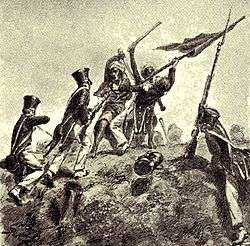Padri War
The Padri War (also called the Minangkabau War) was fought from 1803 until 1837 in West Sumatra, Indonesia between the Padris and the Adats. "Padris" were Muslim clerics from Sumatra who wanted to impose Sharia in Minangkabau country in West Sumatra, Indonesia. "Adats" comprised the Minangkabau nobility and traditional chiefs. The latter asked for the help of the Dutch, who intervened from 1821 and helped the nobility defeat the Padri faction.
| Padri War | |||||||
|---|---|---|---|---|---|---|---|
 An episode of the Padri War. Dutch and Padri soldiers fighting over a Dutch standard in 1831. | |||||||
| |||||||
| Belligerents | |||||||
|
|
Padris (Ulama of Minangkabau) | ||||||
| Commanders and leaders | |||||||
|
| Tuanku Nan Renceh Tuanku Pasaman Tuanku Imam Bonjol Tuanku Rao † Tuanku TambusaiTuanku Nan Alahan | ||||||
Background
It can be considered that the Padri War actually began in 1803, prior to Dutch intervention, and was a conflict that had broken out in Minangkabau country when the Padris started to suppress what they saw as unislamic customs, i.e. the adat. But after occupation of the Pagaruyung Kingdom by Tuanku Pasaman, one of Padri leaders in 1815, on 21 February 1821, the Minangkabau nobility made a deal with Dutch in Padang to help them to fight the Padris.[1]
Adat, as customary law is called in Indonesia, includes indigenous, pre-Islamic religious practices and social traditions in local custom. The Padris, like contemporaneous jihadists in the Sokoto Caliphate of West Africa, were Islamist purists who had made the hajj to Mecca and returned[2] inspired to bring the Qur'an and shariah to a position of greater influence in Sumatra. The Padri movement had formed during the early 19th century and sought to purge the culture of traditions and beliefs its partisans viewed as un-Islamic, including syncretic folk beliefs, cockfighting and Minangkabau matrilineal traditions.
In the 1820s, the Dutch had yet to consolidate their possessions in some parts of the Dutch East Indies (later Indonesia) after re-acquiring it from the British. This was especially true on the island of Sumatra, where some areas would not come under Dutch rule until the 20th century.
Skirmishes and the Masang Treaty
Dutch involvement in the war came about because it was "invited" by the Adat faction, and in April 1821, Dutch troops attacked Simawang and Sulit Air under captains Goffinet and Dienema on the orders of James du Puy, the Dutch Resident in Padang. Between 1821–1824, skirmishes broke out throughout the region, ended only by the Masang Treaty. The war cooled down during the next six years, as the Dutch faced larger-scale uprisings in Java.[3]
Dutch advances
The conflict broke out again in the 1830s with the Dutch gaining early victories. Soon after, the war centred on Bonjol, the fortified last stronghold of the Padris. It finally fell in 1837[4] after being besieged for three years, and along with the exile of Padri leader Tuanku Imam Bonjol, the conflict died out. During the last phases of the conflict, most of the Adat factions, due to the brutality and corruption of the Dutch and their own religious awakening, subsequently joined with the Padris in facing the Dutch.
Impact
With the victory, the Dutch tightened their hold on West Sumatra. Yet there was a positive legacy for the native Minangs: after the war, the traditional and religious leaders increasingly reconciled their visions. This helped promulgating the new view of "adat basandi syara', syara' basandi Kitabullah" ("tradition founded upon Islamic law, Islamic law founded upon the Qur'an").
See also
| Wikimedia Commons has media related to Padri War. |
- Ruit van Bonjol
- Tuanku Imam Bonjol, leader in the Padri movement
Notes
- Sjafnir Aboe Nain, 2004, Memorie Tuanku Imam Bonjol (MTIB), transl., Padang: PPIM.
- The port where they embarked and disembarked, Pedir, Sumatra, gave them their name.
- G. Kepper, 1900, Wapenfeiten van het Nederlands Indische Leger; 1816-1900, M.M. Cuvee, Den Haag.
- Taufik Abdullah (1 January 2009). Indonesia: Towards Democracy. Institute of Southeast Asian Studies. p. 5. ISBN 978-981-230-366-0. Retrieved 25 August 2013.
Further reading
- Dobbin, Christine (1983). Islamic Revivalism in a Changing Peasant Economy: Central Sumatra, 1784-1847. Curzon Press. ISBN 0-7007-0155-9.
- Ricklefs, M. C. (1993) A History of Modern Indonesia since c. 1300. 2d ed. (London: Macmillan), 1993.
- Tarling, Nicholas, (ed.) The Cambridge History of Southeast Asia,, vol. II " The Nineteenth and Twentieth Centuries" (Cambridge University Press) 1992.